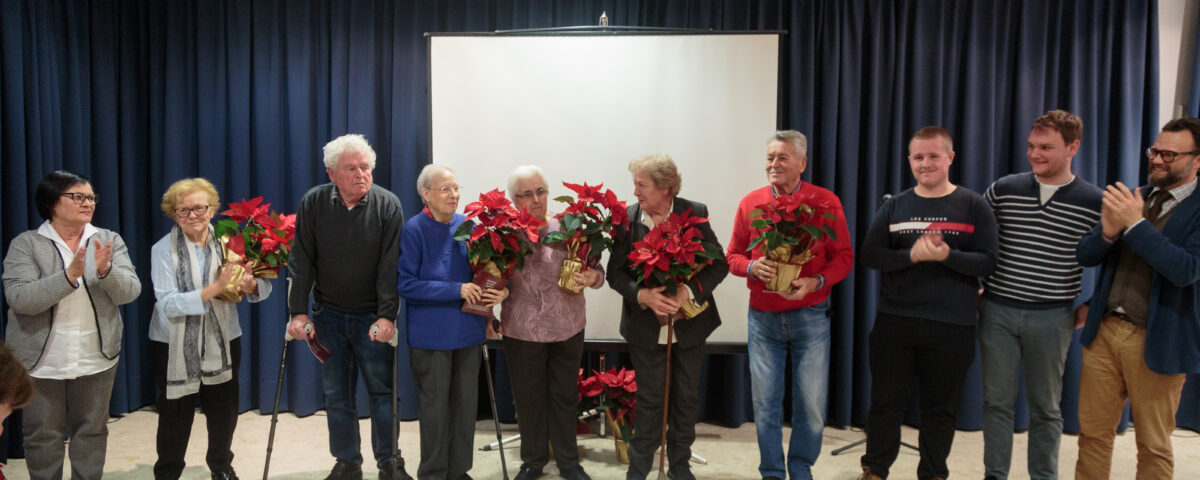Foto: Pogovori z našimi starejšimi

Foto: Predstavitev knjige Il quaderno della cucina Adriatica
12/15/2023
il Trillo n. 71
12/16/2023
V nedeljo, 10. decembra 2023, je v Avditoriju Portorož potekala predstavitev projekta Intervjuji z našimi starejšimi: Piero Rotter, Marcello Vesnaver, Lidia Maria Ruzzier Buršič, Giovanni Petronio, Ondina Lusa, Anna Dessardo, Bianca Ruzzier Zudich, Elena Dugan Ferjančič, Giorgio Bruno Smilovich.
Izvedba projekta: Andrea Bartole v sodelovanju z Danielo Ipsa, Mattio Baničem, Tino Braico in Leonom Kolmanom.
Organizator: Društvo mladih italijanske narodnosti v sodelovanju s Samoupravno skupnostjo italijanske narodnosti Piran in Skupnostjo Italijanov Giuseppe Tartini Piran.
Pogovori s starejšimi za dragocen digitalni arhiv
Zgodbe o preteklosti, ki jih pripovedujejo ljudje, ki so živeli v nekih drugih časih. Zgodbe o življenju, ki se danes zdi nepredstavljivo. Zgodbe o ljudeh, ki so Piran in Istro vzljubili mnogo pred današnjimi rodovi in ki jo nosijo v srcu že skoraj stoletje. Vse te zgodbe se prepletajo v projektu, katerega drugi del so predstavili v avli Avditorija Portorož, 10. decembra 2023. V projektu, ki nosi naslov Testimonianze – interviste ai nostri anziani (Pričevanja – pogovori z našimi starejšimi).
»Projekta smo se lotili z namenom ustvariti digitalni arhiv pogovorov pa tudi zgodovinskega spomina, da bi lahko nekako sestavili in povedali zgodbo istrskega prostora, kakršen je nekoč bil,« je o cilju projekta povedal Andrea Bartole, predsednik Samoupravne skupnosti italijanske narodnosti Piran in pobudnik pogovorov s pričevalci.
Ljudje, rojeni v času pred drugo svetovno vojno, predstavljajo dragoceno enciklopedijo modrosti. V nasprotju z zgodovinarji, ki naj bi vsak po svoje razlagali zgodovino, sami namreč ničesar ne priredijo, saj govorijo o svojem življenju. V življenjskih pripovedih pa glavne vloge niso dodeljene ne levim ne desnim, ne našim ne vašim, temveč spominom, ljudem, občutkom, slikam, vonju in hrepenenju po času, ki ga ni več.
»Žal se je ogromno spominov sčasoma izgubilo. Če ljudem omogočimo, da o njih spregovorijo, mi pa jim prisluhnemo, lahko dejansko obnovimo življenje, kot je bilo nekoč. Oživljamo naš prostor, pa tudi našo identiteto, tradicijo, vse, zaradi česar smo italijanska skupnost, vse, kar nas je naredilo takšne, kot smo danes,« se je Bartole dotaknil vezi med preteklostjo in sedanjostjo.
Na čelu te vezi so uspešno krmarili mladi iz Društva mladih italijanske narodne skupnosti, ki so za projekt prispevali svoja sodobna znanja in sposobnosti. Z njihovo pomočjo je nastal nekaj več kot uro dolg dokumentarni posnetek, ki so ga predvajali na predstavitvi. Lani so opravili deset intervjujev, letos pa jih je nastalo še prav toliko novih.
V drugem delu so se po besedah Bartola odločili, da razširijo krog intervjuvancev tudi na tiste, ki so Piranu že davno pomahali v slovo.
»Šli smo na lov za Pirančani, ki so v petdesetih letih prejšnjega stoletja odšli. Pogovarjali smo se z dvema, Giovannijem Petroniom in Marcellom Vesnaverjem. Ker sta odšla iz Pirana kot majhna dečka, so prav spomini nanj pustili v njima globoke odtise,« je dejal.
Poleg dveh ezulov so v pogovorih, ki jih je ob pomoči Mattie Baniča, Tine Braico in Leona Kolmana opravila neprecenljiva Daniela Ipsa, sodelovali še Pietro Rotter, Lidia Maria Ruzzier Buršič, Ondina Lusa, Anita Dessardo, Bianca Ruzzier Zudich, Elena Dugan Ferjančič in Giorgio Bruno Smilovich. Vsi so se vabilu z veseljem odzvali in Danieli odprli svoje srce.
»Prijetno je bilo poslušati zabavne zgodbe, nekateri pogovori pa so se me zelo dotaknili. Ljudje so bili tako pogumni in pridni, z veliko željo po učenju, rasti, ustvarjanju in odkrivanju sveta. A takratni časi niso ponujali obilja, zato je bila njihova edina želja, da najdejo delo in poskrbijo za svojo družino. Prav zaradi družin, ki so nastajale, smo tudi mi danes tukaj in lahko govorimo o tem,« je pojasnila Daniela Ipsa.
Projekt je plod medgeneracijskega sodelovanja, zato vsi sodelujoči upajo, da se bo nadaljeval.
»Eden od ciljev projekta je tudi primerjava različnih generacij, ki ponuja možnosti za dialog. Zato je to projekt ki je zelo pomemben za nas, mlade, in ga bomo z veliko predanostjo izvajali tudi vnaprej,« je dejal Dyego Tuljak, predsednik Društva mladih italijanske narodne skupnosti.
Ko si preteklost in sedanjost podata roke, se vedno rodi preplet svetov, ki v sebi nosi tako korenine preteklega, ustvarjalnost sedanjega in semena prihodnjega časa.
Besedilo in foto: Nataša Fajon



